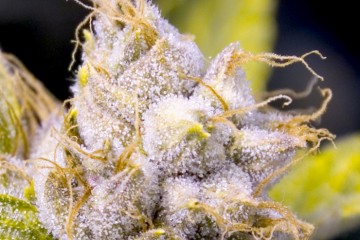CBD & Terpenes: The Entourage Effect

Cannabis is truly one of the most amazing plants on Earth. As the female’s flowering phase progresses, she becomes a virtual chemical factory, producing hundreds of various cannabinoids, flavonoids, terpenes, and terpenoids.
Science is only beginning to understand the role these individual chemical compounds play when ingested in the human body, and much more study is needed. One thing that we do know is that when these compounds are separated from the rest of the plant, they become less effective for the treatment of medical symptoms, and can even produce unwanted side effects that are not present when left combined with one another as nature produces them.
We call this enhanced efficacy “the entourage effect”. Simply stated, there appears to be an exponential health benefit when the various chemical constituents of cannabis are fully represented. This stands in stark contrast to the existing targeted approach of western medicine that endeavors to break everything down into the minimal number of chemical compounds that can effectively target a specific response in the human body in the treatment of symptoms or disease, often with seriously bad side effects.
Unfortunately, this highly targeted pharmacological approach puts modern western medicine at odds with the cannabis plant, which many in the medical field consider to be “crude medicine”. Yet if we are to trust the present conclusions of both pre-clinical scientific and anecdotal studies, we must conclude that in the case of cannabis, crude is actually superior.
Many people are aware that the 2 main cannabinoids found in cannabis are THC (Δ9-tetrahydrocannabinol), which is responsible for the “high” that cannabis is famous for, and the relative newcomer to the party, CBD (cannabidiol), which is rapidly becoming known as the more medicinal, non-psychoactive cannabinoid. Multitudes of studies show a wide range of medicinal benefits connected with CBD, including (but certainly not limited to):
- Antibacterial
- Inhibition of cancer cell growth
- Neuro-protective
- Promotes bone growth
- Reduces seizures and convulsions
- Reduces blood sugar levels
- Regulates function in the immune system
- Reduces inflammation
- Reduces risk of artery blockage
- Reduces small intestine contractions
- Reduces vomiting and nausea
- Relieves pain
- Relieves anxiety
- Slows bacterial growth
- Suppresses muscle spasms
- Tranquilizing
- Treats psoriasis
- Vasorelaxant
Recent pre-clinical studies show great promise utilizing CBD for the treatment of cancer, diabetes, epilepsy, mood disorders, acne, irregular heartbeat, stem-cell neurogenesis, and even mad-cow disease!
Clearly, on it’s own CBD is a pretty amazing molecule that virtually everyone could benefit from. Yet, when combined with the natural terpenes found in various cannabis strains, it’s healing properties are multiplied and the possibilities are nearly as endless as the number of combinations that this amazing plant can provide us with.
Whenever you experience the fragrance of any foliage, flower or fruit, what you are smelling is primarily the plant’s terpenes, which are found throughout nature in abundance. Pine trees are rich in the terpene Pinene. Lemons are full of Limonene. Caryophyllene is found abundantly in cloves. Linalool is a component in many flowers and spices such as lavender and coriander. Both hops and mangos contain Myrcene.
Amazingly, all of these terpenes and many more are almost universally found in varying percentages across the vast spectrum of cannabis strains on the market today. Cannabis breeders have intentionally and lovingly created these strains through the crossbreeding of different phenotypes over the past several decades. These strains vary widely in smell, taste and effect according to the different percentages of terpenes and cannabinoids present.
Each of these specific terpenes also bring their own list of possible medical benefits to the entourage party. The overwhelming popularity of the essential oils movement over the past few years provides significant anecdotal evidence that terpenes (the primary active ingredients in essential oils) hold tremendous potential for human health benefit and disease prevention. Terpene-rich plants are truly nature’s medicine cabinet!
Never before has there been such a vast array of product choices for those who live in states where medical cannabis strains are now showcased in legal dispensaries. It seems certain that it’s only a matter of time before cannabis is legal for medical use in all 50 states as more and more people discover the health benefits it can safely provide.
In the meantime, for those who do not have access to medical cannabis, or for those who want to avoid the psychoactivity of THC, CBD products are a great option. While marijuana remains illegal in many states, when the THC level of measures .3 percent or less, it is officially designated by the Federal government as hemp, and is legal to purchase in all 50 states (depending on who you ask). This makes hemp-based CBD a great option for those seeking the medical benefits of cannabis without the legal or physical downsides of THC.
However, all hemp-based CBD is not created equal. Most CBD comes from industrial hemp imported from Europe or China. Because hemp is a “bio-accumulator”, which effectively pulls any toxins from the soil in which it grows, knowing that your CBD is free from chemicals is critical. Industrial hemp is a poor source for CBD because it takes tons of it to produce even a small amount of oil and any toxins will be concentrated in the oil that is produced.
Further, many CBD companies sell products made from 99% pure CBD isolate, which is highly processed and void of the valuable terpenes and other active ingredients that were present in the plant’s natural state. While this product can be good for certain applications, it is considerably less desirable than products made from a full-spectrum oil that contains the complete entourage of components found in the raw cannabis plant.
The Federal Farm Bill of 2014 made it possible for the states to authorize their own exploratory hemp programs. This has opened up the way for us to have safer, organically produced hemp grown right here in the USA. While there remains some legal debate about selling it across state lines, the consensus of the hemp industry is that US-grown hemp is now a legal product in the US, and production has been growing each year without significant interference from the Federal government. While this may change someday, at this time you can purchase organic, full-spectrum CBD oil-based products from US-grown hemp that are lab-tested to be safe and free from contaminants. This is what you want to look for when buying your CBD products. Once you try one of these products, you can smell and taste the difference.
One company offering such products is Green Flower Botanicals in Tampa Bay, Florida. This small, family-owned company was founded in 2016 by two Christian ministers, and has accumulated an impressive amount of testimonials from satisfied customers who have tried their products for a number of various ailments with notable success. Their CBD tinctures and oils are made only from organically-grown medical hemp from Colorado that measures close to 80% purity in cannabinoid and active components, where the industry average is normally 40% or less. Green Flower Botanicals products stand head and shoulders above the crowd, and their commitment to providing healthy CBD-rich products is rock-solid.
Green Flower Botanicals is currently working on several new product lines which include a CBD-enriched skin care line, CBD for pets and farm animals, and most exciting of all, a new line of CBD tinctures and vapes that include specific terpene profiles of many of the more popular medical cannabis strains. We can’t wait to see what these products can do!
For more information, visit their website at http://greenflowerbotanicals.com.





2 Comments
Why no Facebook (and Twitter) share buttons?
Hi Gordon – they are there at the bottom of the article (below the Amazon ad). Thanks for writing!